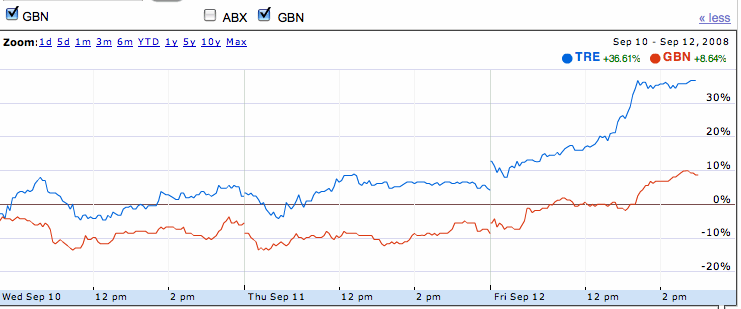warum ?
deshalb: (viel Glück!)
Tanzanian Royalty Identifies New High Grade Gold Mineralization at Kigosi Project, Fast Tracks Explo PDF Print E-mail
Tanzanian Royalty Exploration Corp. (AMEX: TRE) -- A short phase Reverse Circulation (RC) drilling program at the Igunda artisanal workings on the Company's Kigosi Project in Tanzania has intersected high grade gold mineralization.
Significant high grade gold mineralization has been established in the Igunda Main Shear system (IGM) where two closely spaced (18 metres) reefs (A and B) have produced very encouraging high grade gold intersections with up to 30.58g/t. This high grade gold mineralization appears to be confined to quartz-veined chlorite schist shears that are up to 4.0 metres in width down hole.
Igunda is approximately 2.2 kilometres southwest of the main Luhwaika discovery area and is along strike.
With these new encouraging results and previous results at the Luhwaika Prospect (refer to Press Release dated 4th July 2007) the Company has initiated a major push to establish depth extensions to these two encouraging prospects.
At the Luhwaika Prospect, the high grade gold shoots defined thus far are known to run along the dip angle of the shear zones across thicknesses ranging from 1-3 metres. Internal geological studies suggest a high probability that these gold shoots repeat at depth within the vertical plane of the shears.
According to Tanzanian Royalty Chairman and CEO, James E. Sinclair, "The upcoming drill program has important ramifications in terms of establishing the resource potential in these core mineralized areas at Kigosi which we would use in base case economic studies that we intend to launch later this year."
The multiphase drill program will include a 3,000-metre diamond drilling component, which will test the vertical extent of the Main and Luhwaika West shear zones and any gold shoots hosted therein to a vertical depth of 250 metres, said the Company's President, John Deane, who oversees the Kigosi Project Area.
The diamond drilling program is scheduled to commence by the end of September. In addition, RC (1000 metres) and RAB (7000 metres) drilling will be conducted in the Luhwaika and Igunda areas to test additional soil and IP anomalies, both along strike and parallel to the main zones of mineralization already identified.
The recent Phase 1 RC drilling program at Igunda brings the total drilling completed thus far to 1,422 metres in 29 holes on this prospect. Some of the better results from the Igunda program are listed in the following table:
-***-
Hole No From To Intercept Gold Including Comments
(m) (m) (m) g/t
--------------------------------------------------
KG125RC001 31 33 2 20.68 1m @ 30.58 g/t Igunda Main Reef A
--------------------------------------------------
KG125RC002 30 31 1 1.83 Igunda Main Reef B
--------------------------------------------------
77 80 3 15.36 1m @ 20.05 g/t Igunda Main Reef A
--------------------------------------------------
KG125RC007 71 75 4 1.37 1m @ 3.95 g/t Igunda Main Reef A
--------------------------------------------------
95 96 1 14.05 Igunda Main Reef B
-****-
Based on a preliminary interpretation of the down-hole geology and assay results, there appears to be up to three sub-parallel shear zones hosting gold mineralization in and around the Igunda workings.
The Igunda drilling was done on 200 metre-spaced fences in an area where aeromagnetic geophysical data indicates the presence of a dyke structure abutting the workings to the southeast and two significant fault structures to the northwest. The potential significance of these fault structures remains to be determined.
A preliminary assessment of the results suggests that a high grade shoot in the IGM-A shear may extend for at least 250 metres along strike, plunge steeply towards the south at -70 degrees and dip at approximately 85 degrees, much steeper than the relatively flat 22 degrees dip in the Main Luhwaika zone. This steeply dipping feature is generally consistent with gold deposits in major Archean greenstone belts throughout the world.
Further closed-spaced RC drilling (580 metres) is planned to comprehensively investigate the potential of this high grade gold shoot within the Igunda area. This will form part of the current drill program and will commence immediately after RC drilling is completed at Luhwaika in September. Positive results will support deeper diamond drilling that will be included after the diamond drilling that will be conducted at Luhwaika, probably in October.
Twenty eight RC holes have revealed a swarm of sub-parallel quartz veins within the Luhwaika East IP anomaly where high grade gold values have been recorded from gravel beds associated with the system. "This swarm of quartz veins might be the start of another potentially auriferous gold system northwest of the Luhwaika Main reef system," said Deane.
In addition, RAB (Rotary Air Blast) drilling is planned for the Igunda workings and the Igunda West area which host coincident IP and gold-in-soil trends. RAB drilling will also probe for the southeast extension of the mineralized Igunda shear zone and test under overburden (mbunga) in the Luhwaika Gap area. Further RAB drilling is planned for the Luhwaika North IP anomaly immediately northwest of the Luhwaika workings. This area hosts one of the best IP anomalies detected to date, being along strike of Luhwaika, and having a strike of some 1400m, Deane reports.
Analysis
Fire assay with flame AAS finish was conducted by Humac Laboratories in Mwanza. Field Duplicates and Standards were inserted in the sample stream approximately every 20 samples. The field duplicates have a correlation coefficient of 98.85%. 4.5% of the standards (2 values) fall outside the acceptable 2nd standard deviation. All the blanks fall on or below the detection limit of 1ppb. This QC is considered acceptable. The figures used in this press release are the average grades taken for between one and three duplicates run by the labs on each analysis.
|
Angehängte Grafik:
tanz___gbn.gif (verkleinert auf 68%)



 Thread abonnieren
Thread abonnieren


